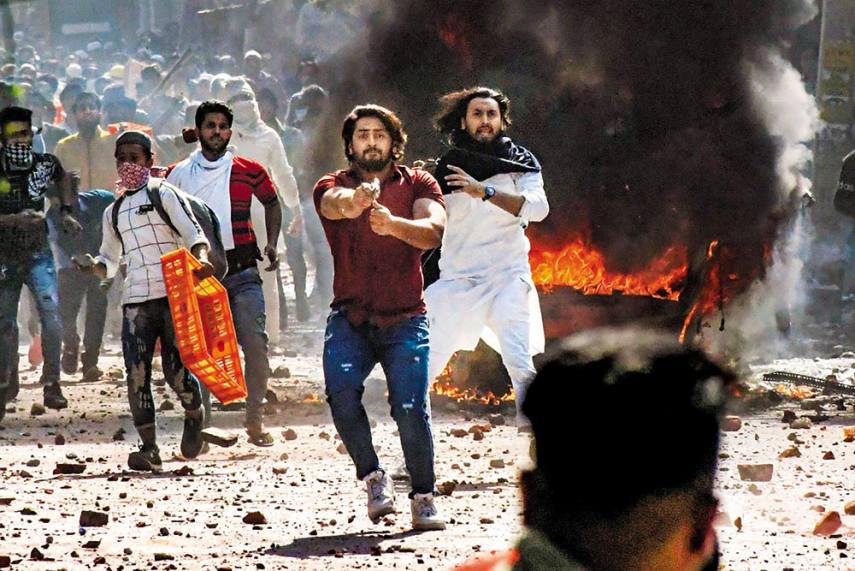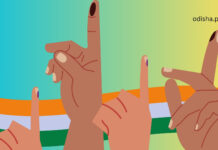Pradeep Kumar Panda

Delhi is certainly burning. It is not about the scale of the casualty or the modus. Just look at the timing, the climate, and the mentality that could induce such maddening mass violence in the Indian capital in 2020.
With no elections round the corner, and with a Donald Trump and international press around, the Delhi mayhem shatters the narrative that India’s communal unrest is motivated solely by electoral politics.
India is a diverse nation in terms of culture, language, religion, caste, people, cuisine and everything. So, after independence, national integration was one of the main tasks for the country. The concept became further important, as various states in India were formed in 1956 on the basis of languages. Moreover, some of the states like Punjab and Jammu and Kashmir even started asking to become a separate country though these were an integral part of India.
If we peep into the history of ancient India, then religion played an important role in uniting the people and the nation. Common devotion created the feeling of affinity that helped in the integration of the nation. Two main languages, Sanskrit and Pali, had also played the same role. But with the invasion of foreign rulers, more religions and languages got added in the country leading to much greater diversification than ever. Feelings of jealousy, and religion-based separation started raising its head and disturbed the country’s unity. With the British rule came their ‘divide and rule’ policy. They created a difference between Hindu and Muslims on the basis of religion and that was the greatest setback to India’s national integration. Along with this, just for the sake of rule, differences between rich and poor, rural and urban, upper and lower had also been created. But, in spite of all this, people were one and we got Independence because of our national unity.
After independence the government favored tolerance, secularism and national integration. The constitution of India tried its best to provide equal opportunities to its entire people irrespective of caste, religion, creed, place of birth etc. Hindi was made an official language of the country. In spite of all the efforts, still there is a gap and the spirit of unity is evaporating quickly. Loyalty to religion and language is more important than devotion to the motherland. The most serious threats to the national integration of India are – linguistic differences, communalism and regionalism. Also issues like intolerance and selfishness are acting as threats to unity.
To achieve this goal, every citizen of India must first identify himself or herself as Indian not as Bengali, Punjabi, south Indian or north Indian. At present, the identification is on the basis of state, language, religion, caste and culture but not at all on the basis of country. Being Indian is our common identifies and we must say it proudly.
Communalism is the greatest challenge that divides our country. Communalism was greatly encouraged during British rule as they wanted to rule our country with their ‘divide and rule’ policy. Then in 1947, with the Partition, communalism played its ugly role again, killing thousands of innocent peoples. So, to promote national integration and unity, one must leave communalism and think above his or her religion. We need to promote communal harmony.
Then we must understand that language is just a way to communicate but it is not meant to define any personality. I am born in a particular family so I have acquired all the traits of that family. But what if I were born in another family and another religion? I must have followed that faith and spoken that language. So, it is your birth that defines your religion, not you. We must respect each other’s language and religion. Due recognition to several languages has been given by in our Constitution. But, we as individuals recognize just one language that we speak, ignoring all other languages. As a responsible citizen we must respect every language that is spoken in India
Since childhood, kids should be taught that they are Indians and deep sense of patriotism must be developed.
We must recognize that India is a diverse nation having different religions, languages, dresses, food, etc. To promote national integration in India, there should be a respect for diversity. All these are nothing but just people’s mindsets. We think and act the way our society wants us to think and act. But all the societal dogmas need to tackled and examined so that we can follow the right path. Education plays an important role in changing the mindset of the people. Along with education that is provided in schools, it is the duty of the parents to guide their kids in the right direction. Parental education needs to be monitored regularly. Parents must work on communal harmony and teach their kids the importance of national integration and unity.
National integration is actually a harmonious situation that binds the people of India together. The nation is built by its people so all the people must live in unity for the development of the nation as a whole. We must have a common identity, as Indians, to promote national integration.
National integration is a word that is popular and common among individuals especially whenever there are peace talks. However few people understand what national integration is and the many benefits that can be reaped form national integration. It is countries that have high levels of national integration that get to achieve high rates of developmental success.
National integration can be referred to as a feeling that citizens or individuals in a country have with regards to togetherness and oneness.
With national integration, people feel like they are one in a country despite their religious, social, racial, cultural or economic background. When there is national integration in a country, the individuals of that country are able to work together to achieve high rates of prosperity and development. It is a term that does not necessarily emphasize on national spirit but rather on working together as one.

One of the features of national integration is unity. Unity in a country is where people join and come together to work for the common good of the country.
Social homogeneity is also a feature of national integration. This is where people in a country see each other as equals despite their different social backgrounds.
National loyalty is also a characteristic of national integration. This is where people love their country and they are devoted towards its growth.
Equal opportunities are also a feature of national integration. People are given a chance towards getting equal opportunities despite their various differences.
National integration leads to the development of national unity. With national unity, people are able to come together despite their differences in terms of religion, race and culture.
Another importance of national integration is that it leads to promotion of patriotism. Patriotism refers to when people in a country are able to remain loyal to their country and fight for their country.
National integration also leads to promotion of national peace. Citizens in a country are able to work together despite their differences and this further leads to the growth of a country.
National integration contributes to a country’s economic growth. This is because peaceful coexistence among individual makes it easier for them to work together to grow the economy.
National integration also leads to political stability. This is because of the elimination of fear that if someone from a particular race or religion got to be elected they would oppress the other people. National integration helps to get rid of this fear.
Another importance of national integration is that it gives a sense of national direction. This is because the goals of a country are well defined and people can cooperate towards achieving these goals.
National integration promotes equality. Every citizen in the country gets an equal chance when it comes to issues like employment, election, etc.
Cultural integration is one of the ways in which we can promote national integration. This is where different groups of people in a country are recognized and interactions between these two groups are promoted.
National integration can also be promoted through education. When people in a country are educated. They are better able to coexist together since they gain more knowledge of the benefits of working together as a country.
When there is fair distribution of national resources, people in a country would be able to coexist peacefully since there would be no tussles over some people feeling like they are doing better than others.
National symbols also promote national integration. National symbols include the national flag, national anthem etc. These symbols will promote unity among people and hence people will be able to work together towards development.
The constitution will also foster national integration. This is because it clearly outlines the rights of people that will make them equal and hence enable them to work together.
National integration is a factor that promotes peace in a country. There are many different groups of people that are present in a country and we have to ensure that all these group of people are able to coexist together.
The main problem before our nation today is the danger to its unity. We are a nation of diversities based on religion, region, language, culture, etc. When we look at the world scenario we find that many nations have split into pieces due to diversities much less as compared to us. In the circumstances it is very necessary that if we intend keeping India as a one nation we must imbibe the spirit of oneness in all minds of our citizens and wake them to the necessity of rising above the barriers. Needless to say it can best done at the adolescent or youth age, which is an impressionable period of life. There is certainly need of inculcating the spirit of national integration and communal harmony in one’s mind.
The vast and multidimensional country India has glorious legacy of rich history minerals, forest and other natural wealth, beautiful rivers and mountains and talented citizens. The country still suffers from some shortcomings that are eating into the very vitals of its glory. The country’s youths who are the future citizens, are naturally concerned with the state of affairs in their country.
The real strength of the movement is the many dedicated workers who volunteer time for every programme. Because we envisaged a movement spread all over the country, it can be done only through a band of dedicated workers, who work for their love of the mission and not for getting financial gains. These worker include college professors, peace researchers, school teachers, lawyers, social workers, business persons, house wives, freedom fighters and many others. Some retired persons are really helpful. Retired persons can render big service to Mother India by joining hands with the youth in constructive work.
In our country, as also elsewhere, normally the whole governmental and non-governmental machinery comes into play once violence occurs. But what is needed is to create an atmosphere in the country and in the world so that no such situation occurs at all. The youths after going through camps are trying to establish ‘SadbhavnaSamiitis’ in villages and mohallas or localities in town. Citizens also could take the initiatives to constitute SatbhavnaSamitis. A minimum programme that SadbhavanaSamitis could do is to organize at least one all religions prayer meeting every month say on full moon day. Then, they could organize religious festivals of all religions in public, inviting people or other religions also for the programmes. In case of natural or manmade calamities youths force has shown to be most helpful. The need today is to have hundreds of youth camps and other programmers. In character formation, moral building sustaining dedication to the mission songs can be a motivating force.
Need of the hour is peace and normalcy in Delhi. Lets us all spread message of peace, harmony and national integration.
(The author is a New Delhi based Economist)




















